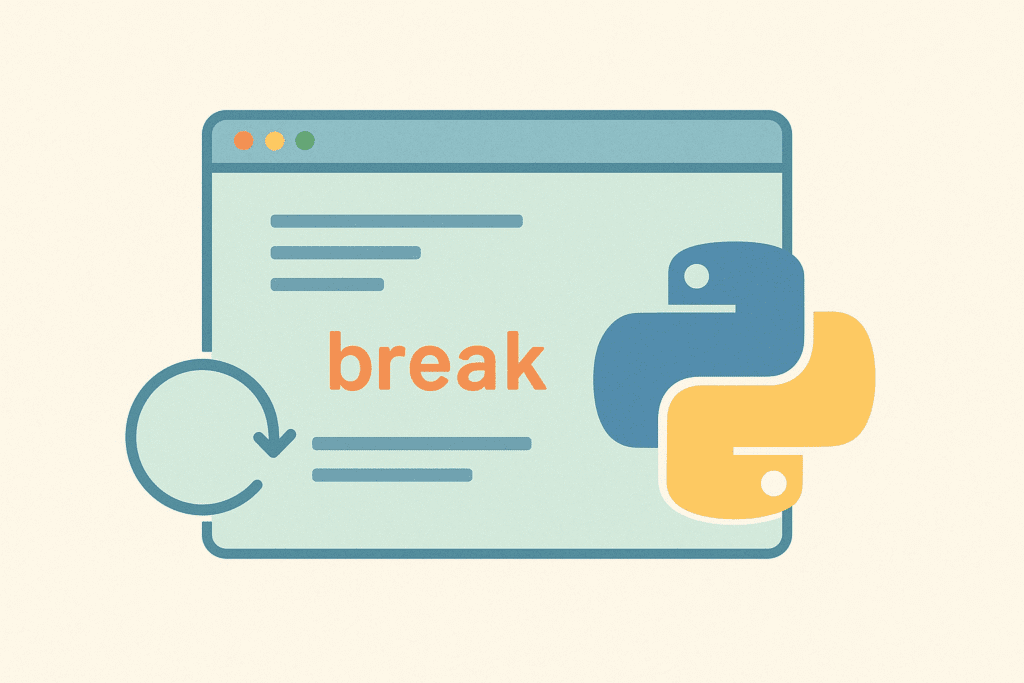When writing Python programs, loops are one of the most powerful and frequently used features. However, sometimes you need more control over the loop flow. The break statement in Python allows you to immediately exit a loop before it finishes all its iterations. This article explains how the break statement works in for loops and while loops, including examples, real-world use cases, and common mistakes beginners make.

What Is the Break Statement in Python?
The break statement is used to stop the execution of a loop prematurely. When the Python interpreter encounters a break statement inside a loop, it immediately terminates the loop and continues execution with the next line of code after the loop.
Syntax:
break
That’s it! It’s a single keyword with no parameters, but it can completely change the control flow of your program.
Basic Example of the Break Statement
Let’s start with a simple example using a for loop.
# Example 1: Using break in a for loop
for number in range(1, 10):
if number == 5:
print("Breaking the loop at number:", number)
break
print("Current number is:", number)
print("Loop has ended.")
Output:
Current number is: 1 Current number is: 2 Current number is: 3 Current number is: 4 Breaking the loop at number: 5 Loop has ended.
In this example, the loop stops when the variable number reaches 5. Even though the range(1, 10) goes up to 9, the loop doesn’t continue after the break statement.
Using Break in a While Loop
The break statement also works perfectly with while loops. This is very useful when you want to keep looping until a specific condition is met — even if it’s not directly related to the loop’s original condition.
# Example 2: Using break in a while loop
count = 0
while True:
print("Count is:", count)
count += 1
if count == 5:
print("Breaking the loop at count 5")
break
print("While loop finished.")
Output:
Count is: 0 Count is: 1 Count is: 2 Count is: 3 Count is: 4 Breaking the loop at count 5 While loop finished.
This example uses an infinite loop while True, but the break statement allows us to safely exit the loop once a specific condition is satisfied.
Real-World Example: Searching for an Element
Let’s use the break statement in a more practical situation. Suppose you want to check if a certain item exists in a list.
# Example 3: Searching for a name in a list
names = ["Alice", "Bob", "Charlie", "David", "Eve"]
target = "Charlie"
for name in names:
if name == target:
print(f"{target} found in the list!")
break
else:
print(f"{target} not found in the list.")
Output:
Charlie found in the list!
This example also introduces the for-else construct in Python. The else block executes only if the loop completes normally (without a break). In this case, since the loop breaks when Charlie is found, the else part does not run.
Nested Loops with Break
If you have nested loops, the break statement only exits the innermost loop where it is executed. To stop multiple levels of loops, you need additional logic.
# Example 4: Break inside nested loops
for i in range(3):
for j in range(3):
print(f"i={i}, j={j}")
if j == 1:
print("Breaking inner loop")
break
print("End of inner loop")
Output:
i=0, j=0 i=0, j=1 Breaking inner loop End of inner loop i=1, j=0 i=1, j=1 Breaking inner loop End of inner loop i=2, j=0 i=2, j=1 Breaking inner loop End of inner loop
Notice that the break only stops the inner loop, while the outer loop continues running. If you want to break both loops, you can use flags or functions to handle that logic.
Common Mistakes When Using Break
- Forgetting the break condition: If your condition never becomes true, the loop may run indefinitely.
- Using break in the wrong loop: Remember, break only affects the nearest enclosing loop.
- Confusing break and continue: The
continuestatement skips the current iteration but doesn’t stop the loop entirely.
Break vs Continue vs Pass
Python provides several loop control statements. Let’s compare them:
| Statement | Behavior | Example |
|---|---|---|
break | Stops the loop entirely. | if x == 5: break |
continue | Skips the current iteration and continues with the next one. | if x == 5: continue |
pass | Does nothing; a placeholder statement. | if x == 5: pass |
Practical Use Case: Validating User Input
Here’s a simple example where the break statement is used to exit a loop after receiving valid input from a user.
# Example 5: Validating user input
while True:
password = input("Enter your password (min 6 chars): ")
if len(password) >= 6:
print("Password accepted.")
break
else:
print("Password too short. Try again.")
In this case, the loop keeps running until the user enters a valid password. Once the condition is met, the break exits the loop safely.
Conclusion
The break statement is one of Python’s simplest yet most powerful loop control tools. It lets you exit loops early when a specific condition is met, making your code cleaner and more efficient. Understanding when and how to use break properly can save time, prevent infinite loops, and improve program logic.
If you’re learning Python, experiment with different loop control statements like break, continue, and pass to see how they affect your program’s flow.
For more in-depth learning, check out the official Python documentation on loops:
Python Control Flow – Official Docs.

